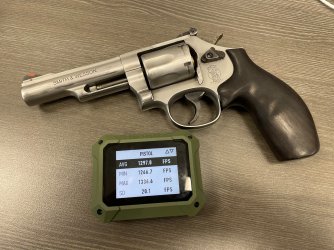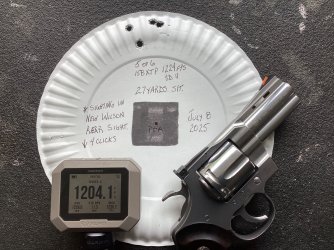I recently got a new chronograph so Ive been nerding out a little bit with it.
Thought this data might be of interest here as far as velocity differences go between barrel lengths of current Smiths. I dont intend for anyone to copy the load data as some of these loadings can be dangerous in the wrong combination of gun.
These are all from current catalog offerings of Smith. Guns used were a 1 7/8" 642, 3" 686+ and a 4 1/4" 66
I seat these HBWC just sub flush and add a roll crimp. The 642 velocity is not a typo. My 642 shoots this load a little faster than my 3" 686 per the chrono. It had a few push into the 800s which skewed the data upward but its what it reported.
Average FPS of 10 shot groups with each gun and load
148GR HBWC load with 3.5 grains of 231.
4.25" 66 - 810 FPS
3" 686 - 770 FPS
642 - 780FPS
160GR 358439 Cast Keith HP with 4.0 grains of 231. Standard 38 load
4.25" 66 - 792 FPS
3" 686 - 764 FPS
642 - 744 FPS
160GR 358439 Cast Keith HP with 4.5 grains of 231. +P loading. I dropped off the 642 here as the +P version really pushes the POI high in it so I dont use it.
4.25" 66 - 897FPS
3" 686 - 852 FPS
160GR 358439 Cast Keith HP with 8.2 grains of HS6. This is a 38/44 loading I have duplicated. This one is near magnum and HIGH PRESSURE. DO NOT USE IN ALLOY FRAME 38s
4.25" 66 - 1162 FPS
3" 686 - 1103 FPS
Thought this data might be of interest here as far as velocity differences go between barrel lengths of current Smiths. I dont intend for anyone to copy the load data as some of these loadings can be dangerous in the wrong combination of gun.
These are all from current catalog offerings of Smith. Guns used were a 1 7/8" 642, 3" 686+ and a 4 1/4" 66
I seat these HBWC just sub flush and add a roll crimp. The 642 velocity is not a typo. My 642 shoots this load a little faster than my 3" 686 per the chrono. It had a few push into the 800s which skewed the data upward but its what it reported.
Average FPS of 10 shot groups with each gun and load
148GR HBWC load with 3.5 grains of 231.
4.25" 66 - 810 FPS
3" 686 - 770 FPS
642 - 780FPS
160GR 358439 Cast Keith HP with 4.0 grains of 231. Standard 38 load
4.25" 66 - 792 FPS
3" 686 - 764 FPS
642 - 744 FPS
160GR 358439 Cast Keith HP with 4.5 grains of 231. +P loading. I dropped off the 642 here as the +P version really pushes the POI high in it so I dont use it.
4.25" 66 - 897FPS
3" 686 - 852 FPS
160GR 358439 Cast Keith HP with 8.2 grains of HS6. This is a 38/44 loading I have duplicated. This one is near magnum and HIGH PRESSURE. DO NOT USE IN ALLOY FRAME 38s
4.25" 66 - 1162 FPS
3" 686 - 1103 FPS
Last edited:


